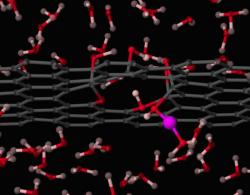A collaboration of scientists from several institutions, including Northwestern, EFRC and more, discovered that graphene that is slightly imperfect can shuttle protons from one side of a graphene membrane to the other in seconds. The selectivity and speed of the imperfect version are compared to conventional membranes, opening the door to new and simpler model of fuel cell designs.

This, of course, goes against conventional efforts to create perfect graphene as it turns out that protons move better through imperfect graphene. The defects in the graphene trigger a chemical "conveyor belt" that shuttles protons from one side of the membrane to the other in a few seconds. In conventional membranes, which can be hundreds of nanometers thick, the desired proton selection takes minutes, compared to the quick transfer in a one-atom-thick layer of graphene.
This offers a way to create a quicker and more efficient proton separation membrane than ever before. This could, potentially, result in an electric car that charges very quickly, or even uses hydrogen as fuel instead of fossil fuels or ethanol.